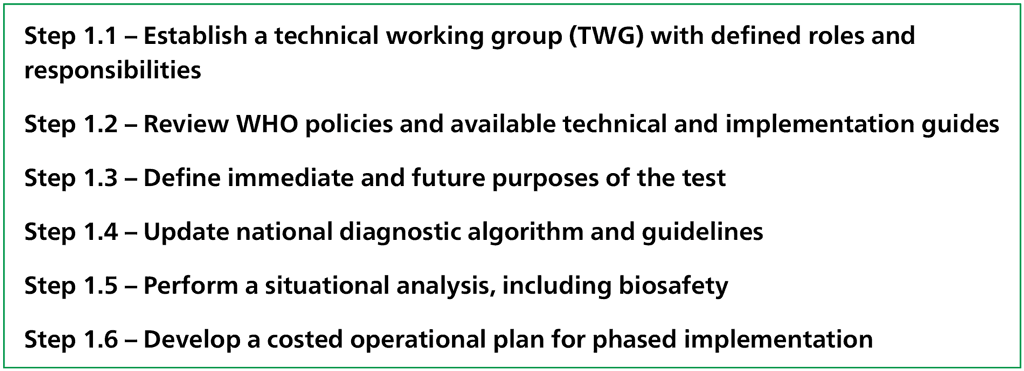Enlaces transversales de Book para 1266

Step 1.1 – Establish a TWG with defined roles and responsibilities
A TWG comprising representatives from all key stakeholders should be established to guide the implementation process. It is important to include representatives from other disease programmes or the national laboratory directorate, particularly if multidisease testing is planned. The establishment of the TWG should be led by the ministry of health, NTP and national TB reference laboratory (NTRL). The TWG should be mandated to advise the ministry of health, NTP and NTRL on national policy and test implementation; develop action plans and implementation tools (e.g. testing algorithms, SOPs and protocols); and oversee the test’s implementation. The TWG should also monitor the quality of implementation; suggest steps to address gaps in implementation across the cascade of care; and assess the impact and success of the test’s introduction. Representatives from the following key stakeholders may be invited to participate:
- ministry of health, NTP, national programmes (e.g. HIV/AIDS programmes and noncommunicable disease programmes), NTRL(s) and regional laboratories;
- multisectoral representatives for the implementation of tests for TB infection (e.g. correctional services and mining);
- research institutes or other organizations with experience using the new diagnostic test;
- implementing partners, including those outside of TB;
- peripheral laboratories and clinical facilities that will participate in the testing;
- regulatory bodies;
- data management or IT experts and managers who can enable the interoperability of electronic systems;
- specimen transport system logisticians for centralized or regional testing (TB and non-TB);
- other technical and implementing partners (in addition to representatives of TB and HIV programmes) and other United Nations agencies;
- community and civil society representatives; and
- clinical staff.
A suitably qualified individual should lead the team; for example, a national TB laboratory officer or laboratory focal person from the NTP or NTRL. An integral component of the planning process should be defining the roles and responsibilities of members of the implementation team, and those of external partners and donors.
Step 1.2 – Review WHO policies and available technical and implementation guides
The TWG members should familiarize themselves with the contents of the relevant WHO policies, guidance, handbooks and reports, as well as any available implementation guides from WHO, GLI, the Foundation for Innovative New Diagnostics (FIND) and implementing partners. Particular attention should be paid to WHO policies and recommendations on using the test to aid in the diagnosis of TB or detection of drug resistance, who to test, how to conduct the test, the limitations of the test and interpretation of test results.
Step 1.3 – Define immediate and future purposes of the test
Programmes must clearly define the purpose, scope and intended use of the new diagnostic test because that will affect many aspects of the implementation plan, including resources. For example, the laboratory system or network needed to provide timely results for patient-care decisions is quite different from that needed to conduct a once-a-year drug-resistance survey.
Step 1.4 – Update national diagnostic algorithm and guidelines
The TWG should undertake a review of existing national diagnostic algorithms, taking into consideration the needs of people with TB, clinical needs, the country’s epidemiology, existing testing algorithms, sample referral systems and other operational considerations; it should also make recommendations to the ministry of health and NTP. Section 6 provides details on model algorithms for the use of WHO-recommended tests in detail.
The TWG should also lead a review of guidelines for the use of the new diagnostic test results in patient-care decisions. Clinical guidelines should provide clear guidance to clinicians, nurses and health care professionals on the intended use of the new diagnostic test; outline target populations; explain how to order the test; and explain how to interpret, use and communicate test results.
Step 1.5 – Perform a situational analysis, including biosafety
To inform plans for implementing the new diagnostic test, a situational analysis of the existing laboratory network and capacities should be conducted. For most tests, key elements to be assessed include regulatory requirements; laboratory and network infrastructure; existing sample transportation system; staff skills, expertise and experience; IT capabilities and infrastructure; diagnostics connectivity; availability and adequacy of SOPs; supply chain; financial resources; and QA systems and resources. The assessment should inform selection of testing sites; it should also determine needs for revision of training, recording and reporting forms, and tools for monitoring and evaluation. Of particular relevance is the specimen referral system; a checklist for evaluating such a system can be found in the relevant GLI publication (63), and a checklist for implementing targeted NGS tests can be found in the NGS technical guide (33).
Step 1.6 – Develop a costed operational plan for phased implementation
The final step in this area is to develop a detailed, costed and prioritized action plan for phased implementation, with (coverage) targets and timeline. Often, implementation of a new test involves startup costs associated with the procurement and installation of instruments, ancillary equipment and consumables; requirements for improving or establishing the necessary laboratory and network infrastructure (e.g. a specimen transport system); specialized, skilled and well-trained staff; expert technical assistance; maintenance of confidentiality of patient information; and establishment of a QA system.
Successful implementation of the plan will require financial and human resource commitments from the ministry of health or NTP, with possible support from implementing partners. A budget should be developed to address activities in collaboration with key partners. Budget considerations are summarized in Annex 1.
As an example, because of the high cost of targeted NGS-based DST (i.e. initial equipment and running costs), a carefully worked out plan covering all costs of implementation and operation will be needed. Testing volumes and batch sizes will impact cost and the turnaround times of NGS-based DST; they are described in detail elsewhere (33).

 Reacción
Reacción